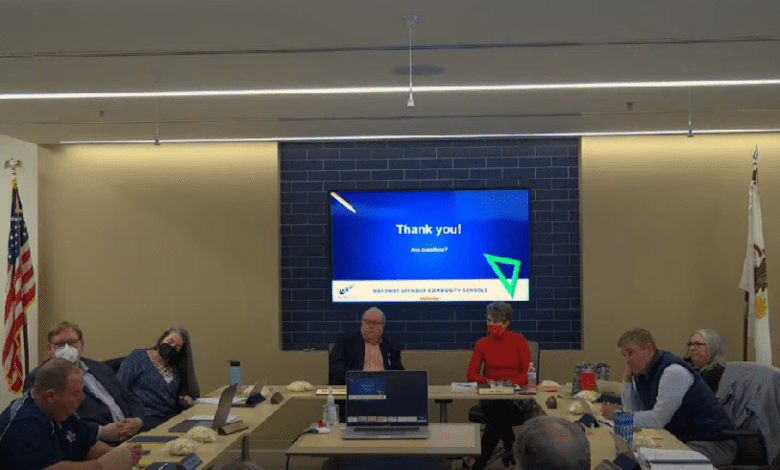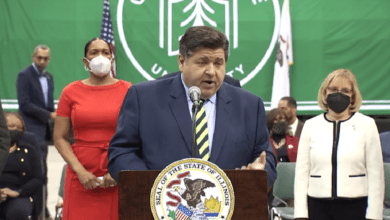Mahomet-Seymour board to vote on $97.9 million tax referendum to address capacity issues

The Mahomet-Seymour School board will vote Tuesday (Feb. 22) on whether or not to accept the Bulldog Blueprint recommendation of a $97.9 million bond issue to be placed on the ballot on June 28, 2022. The language for the referendum is expected to come to the board on March 21.
Phase I ($97.9 million) of the total $128.4 million project will include:
-Demolition of the existing Mahomet-Seymour Junior High School building;
-Build a new 6-8 building on the district’s east campus between the extended South Mahomet Road and the railroad tracks;
-A fine arts addition and renovation of current band/chorus/auditorium spaces for classrooms at Mahomet-Seymour High School;
-An additional eleven classrooms and common spaces at Lincoln Trail;
-An additional 10 classrooms at Middletown Prairie Elementary.
Mahomet-Seymour High School is expected to go from 205,345 square feet to 240,345 square feet; Mahomet-Seymour Junior High will go from 88,691 square feet to 140,000 square feet; Lincoln Trail will go from 76,167 square feet to 101,167 square feet and Middletown Prairie, completed in 2018, will go from 122,616 square feet to 135,616 square feet.
In an email to board member Meghan Hennesy, Schlitt projects classroom sizes to be (maximum):
Kindergarten:21;
First:23;
Second:25;
Third:28;
Fourth:28;
Fifth:28;
Sixth:30;
Seventh:30
Eighth:30;
Ninth:30;
Tenth:30;
Eleventh:30;
Twelfth:30.
“Please note, the figures above are based on targets understood by our buildings and are what we work within as a district to maintain,” Schlitt wrote. “I can tell you that the programs outlined for 3-5 and 6-12, those used in the Bulldog Blueprint planning CAN support smaller per-class sizes (as much as 3-5 students per class below those quoted above and as I stated on Monday night) but those are not always reflected across the board, and are impacted by staffing – a conversation beyond facility planning.
“It should also be noted that class size is a very minor indicator of success in the classroom in a district of our demographics. Class size is a major factor in schools with high poverty rates and other extenuating circumstances.
“We also reviewed this subject in CES #4 and you can see some of the factors we discussed that would make this class size conversation eb and flow regardless of buidling size. Having enough teachers available (hired or to hire), being able to afford them, bubble classes that break all the rules, and even support programs that for some students are as, if not more important than the work in the regular classroom.”
The plan will also provide additional parking spaces, athletic field upgrades at Mahomet-Seymour High School and athletic fields on the Mahomet-Seymour Junior High property, and move the bus barn.
Additional funds for other additions or renovations are projected to come from bonds or sales tax dollars that will come available in the future.
The Blueprint was based on enrollment projections, which were updated in 2021 after the 2019 projections fell short. New enrollment projections believe that total enrollment throughout the district will be 3583 in 2030.
Schlitt said he believes the projections, based on platted development in March 2021, not future development, will take the district through 2040, at which point Mahomet-Seymour will need to look at another plan or referendum. Should the referendum pass in 2022, taxpayers will see that tax increase until 2042.
For a $97.9 million referendum, homeowners can expect (* Taxable values calculated at 1/3 of Market Value less a $6,000 Homeowner Occupied Exemption)
- a house of market value at $150,000 would see a $414 annual tax increase;
- a house with a market value of $200,000 would see a $570 annual tax increase;
- a house with a market value of $250,000 would see a $727 annual tax increase;
- a house with a market value of $300,000 would see a $884 annual tax increase;
- a house with a market value of $350,000 would see a $1053 annual tax increase;
- a house with a market value of $400,000 would see a $1,197 annual tax increase;
- a house with a market value of $450,000 would see a $1,354 annual tax increase.
Board member Jeremy Henrichs asked about what other options might be available to plan for capacity even further down the road than 2040.
“That’s only 16 years after we finished construction, and we’re kind of at a point where it’s not ideal,” he said.
“So like 15 years from now, we’re not having another conversation about, ‘we spend another $80 million to build.”
Schlitt and district Chief School Business Official Heather Smith said that at that time, the district’s financial status may look different, with sales tax dollars or bonds coming available, and that they may be able to find financing for those projects without having to go back to taxpayers for additional property tax dollars.
Schlitt said that plans for the new junior high school will have the building set off the railroad tracks on the 30-acre property on the southeast corner of the Village. In an email interview, Schlitt added that the junior high school will be planned for 900 students, including all physical education, administration, food service, academic, and support spaces.
Plans for the junior high are not yet developed, according to Schlitt, but he said the number of classrooms within the building “will be directly developed from the input of faculty and staff and administration teams to meet the educational goals of the MS school district.”
“We are planning towards understood space needs for the enrollment that we expect to support in this facility, and have budgeted accordingly,” Schlitt said.
“Especially in a Middle School, similar to a (high school), there are not ‘homerooms’ and the number of classrooms could be majorly affected by the way they are assigned. Factors like collaboration, and break-out can actually replace the need for a ‘classroom’, a factor that is often not an option in an elementary school.
“If we have teachers’ offices, for instance (which is not assumed, recommended, or understood at this point), that means we can use classrooms 100-percent of the time and therefore could have less classrooms. If we have shared offices, where we can use classrooms 9/10 periods a day, that is another variation. If we assign a room per teacher and can only assign them 7 or 8 periods a day, you can see how that requires yet a different quantity of classrooms.
“Add to this, the reality that some ‘Classrooms’ are for specific programs (health) while others are for science, or even advanced math – these all change if these are full classrooms, assigned, shared, etc.”
According to Schlitt there are about “33 ‘classrooms’ but I would say that only 27 are sized appropriately. This not only includes general classroom spaces, but specials, science labs, and (special ed.) rooms.”





One Comment